Addis Ababa: Big-City Chaos
You know you're a New Yorker when in a city known for scamming, you scam someone right back.
"I'm a waiter at your hotel, I saw you at the reception, remember?" Silesh said.
I decided to wait and see where he was going with this. When I tried to rent a SIM card, Silesh cried, "no no! Use my card, I lost my phone so I'm not even using it, please use mine." Ah, but in English, that amounts to "borrow."
As we approached Taitu Hotel, he mumbled that he didn't want to see his manager and tried to charge me for the SIM. Scoffing, I said I'd return the card if he paid me for the 25 birr credit I added. He violently disagreed, so I walked into the hotel waving off his protests as the security guard held him back.
While leisurely drinking a beer on the patio, I noticed he'd persuaded the guard to let him in. To avoid causing any problems for the staff, we discussed it until he grudgingly agreed to the "borrow" concept. The hotel clerks confirmed that they'd never seen Silesh before.
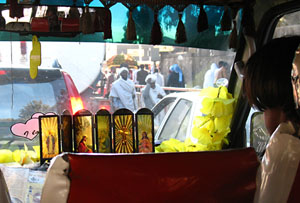 View from inside an Addis minibus |
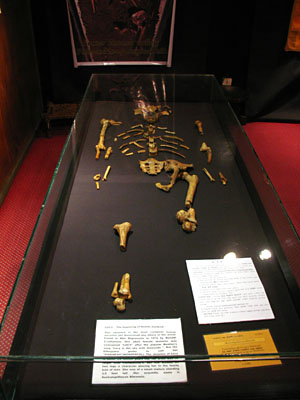 Lucy's 3.5-million-year-old bones |
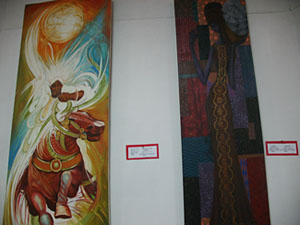 Paintings in the National Museum |
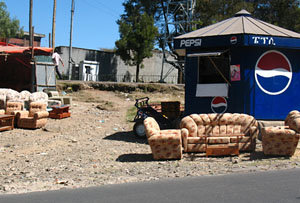 Random! Spotted on my long walk back to the Piazza. |
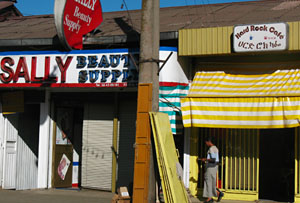 Vibrant, bustling Addis street. With Hard Rock Cafe! |
The restaurant Raj & Anshal had chosen, Bombay Brasserie, was extraordinarily hard to find. Just my luck Anshal's family chose a place that no one had ever heard of. I practically toured all of Addis for 45 frustrating minutes, but was rewarded with a table laden with delicious Indian appetizers and the relaxation of being among friends.
The next day I got off to a slow start trying to find the National Museum. Maps are not geared toward Africans, whose eyes glaze over when I point out my desired destinations. I could not understand how there could be minibuses heading to the National Museum, but not returning. Unable to explain, the staff urged me to take a taxi.
Stubbornly, I boarded the blue-and-white minibus, and as I paid my 1 birr fare, a nice young man speaking excellent English confirmed that minibuses do not return to the Piazza. As I thumbed through my Bradt guide, Haile Michael shyly asked if he could have it, as he was studying to be a tour guide. Because of my sentimental attachment to things, I ended up sending him an inexpensive used copy purchased off eBay.
The National Museum lies between Arat Kilo and Siddist Kilo (respectively, 4 kilometers and 6 kilometers out of the center), but Simst (five) Kilo is not marked with a roundabout. Haile Michael walked me to the Museum's entrance through the crowds; the Ethiopian calendar is jammed full of holy days and the Kiddist Maryam Church around the corner was full of white-robed worshippers this Monday.
The museum was the only place I'd been that clearly indicated ferengi price (10 birr) and local price (1 birr). Quite a bargain for seeing the bones of Lucy, the 3.5 million-year-old skeleton discovered in Hadare in 1974. The simple basement displays explained the geological and anthropological background through various rooms with Lucy's bones and a replica as the big finale. The floors above contained ever-more modern displays, from artifacts of the Tigrai civilization, to traditional clothing of the various tribes, to paintings and sculpture by modern artists.
With the famed Blue Tops restaurant closed on Mondays, I decided to head back to the Piazza for lunch and took a chance on the bus. Hearing an assistant cry out something that sounded like "DeGaulle"—as in DeGaulle Square near my hotel—I jumped on and noticed we were going straight down Entoto Avenue instead of turning right at Adwa toward the Piazza. Ashamed of my mistake, I waited too long to speak up. Eventually I spoke to the driver's assistant who was shocked that I'd gone so far out of my way. He pointed vaguely in the direction of the Piazza.
More than 30 minutes of wandering the streets, not spotting any taxis, periodically asking any random pedestrian for directions, I came across a friendly woman who'd lived in the States for a while but returned to care for her elderly mother. Warning me that walking in this area wasn't safe, she quickly locked her front door and kindly accompanied me to Taitu.
I asked some girls at the internet café for silver-shopping suggestions and instead of the Mercato or the places on Churchill Road that Semqua had recommended, they shopped on Adwa Avenue, right in the Piazza. When I tried to show them my map to confirm the location, they waved it away and said they couldn't read maps.
Once I passed Empire Cinema, I saw endless shops of gold and silver. I wasn't as impressed as I'd hoped to be; my TESFA guide Mulay had told me artisans in Addis were more talented than in Lalibela, but I actually preferred the heavy, dark antique-looking crosses from Lalibela to the refined, delicate pieces in Addis. Perhaps Churchill Road had better quality but this jewelry district certainly had the density and was patronized only by locals.